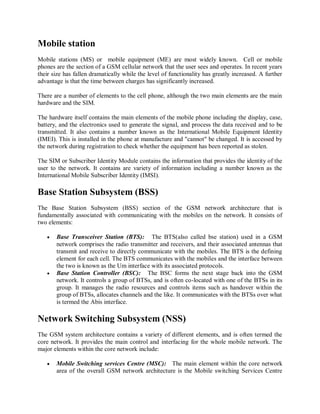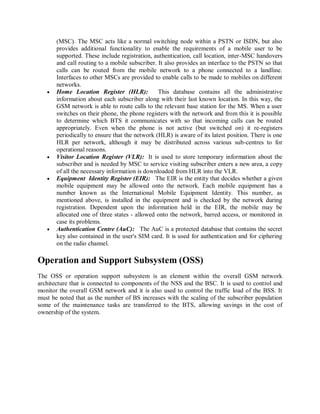Ec module 3
- 1. GSM (Global System for Mobiles) The GSM technical specifications define the different elements within the GSM network architecture. It defines the different elements and the ways in which they interact to enable the overall system operation to be maintained. The GSM network architecture is now well established and with the other later cellular systems now established and other new ones being deployed, the basic GSM network architecture has been updated to interface to the network elements required by these systems. Despite the developments of the newer systems, the basic GSM system architecture has been maintained, and the network elements described below perform the same functions as they did when the original GSM system was launched in the early 1990s. GSM network architecture elements The GSM network architecture as defined in the GSM specifications can be grouped into four main areas: Mobile station (MS) Base-Station Subsystem (BSS) Network and Switching Subsystem (NSS) Operation and Support Subsystem (OSS) The different elements of the GSM network operate together and the user is not aware of the different entities within the system. A basic diagram of the overall GSM system architecture with these four major elements is shown below: Simplified GSM Network Architecture Diagram
- 2. Mobile station Mobile stations (MS) or mobile equipment (ME) are most widely known. Cell or mobile phones are the section of a GSM cellular network that the user sees and operates. In recent years their size has fallen dramatically while the level of functionality has greatly increased. A further advantage is that the time between charges has significantly increased. There are a number of elements to the cell phone, although the two main elements are the main hardware and the SIM. The hardware itself contains the main elements of the mobile phone including the display, case, battery, and the electronics used to generate the signal, and process the data received and to be transmitted. It also contains a number known as the International Mobile Equipment Identity (IMEI). This is installed in the phone at manufacture and "cannot" be changed. It is accessed by the network during registration to check whether the equipment has been reported as stolen. The SIM or Subscriber Identity Module contains the information that provides the identity of the user to the network. It contains are variety of information including a number known as the International Mobile Subscriber Identity (IMSI). Base Station Subsystem (BSS) The Base Station Subsystem (BSS) section of the GSM network architecture that is fundamentally associated with communicating with the mobiles on the network. It consists of two elements: Base Transceiver Station (BTS): The BTS(also called bse station) used in a GSM network comprises the radio transmitter and receivers, and their associated antennas that transmit and receive to directly communicate with the mobiles. The BTS is the defining element for each cell. The BTS communicates with the mobiles and the interface between the two is known as the Um interface with its associated protocols. Base Station Controller (BSC): The BSC forms the next stage back into the GSM network. It controls a group of BTSs, and is often co-located with one of the BTSs in its group. It manages the radio resources and controls items such as handover within the group of BTSs, allocates channels and the like. It communicates with the BTSs over what is termed the Abis interface. Network Switching Subsystem (NSS) The GSM system architecture contains a variety of different elements, and is often termed the core network. It provides the main control and interfacing for the whole mobile network. The major elements within the core network include: Mobile Switching services Centre (MSC): The main element within the core network area of the overall GSM network architecture is the Mobile switching Services Centre
- 3. (MSC). The MSC acts like a normal switching node within a PSTN or ISDN, but also provides additional functionality to enable the requirements of a mobile user to be supported. These include registration, authentication, call location, inter-MSC handovers and call routing to a mobile subscriber. It also provides an interface to the PSTN so that calls can be routed from the mobile network to a phone connected to a landline. Interfaces to other MSCs are provided to enable calls to be made to mobiles on different networks. Home Location Register (HLR): This database contains all the administrative information about each subscriber along with their last known location. In this way, the GSM network is able to route calls to the relevant base station for the MS. When a user switches on their phone, the phone registers with the network and from this it is possible to determine which BTS it communicates with so that incoming calls can be routed appropriately. Even when the phone is not active (but switched on) it re-registers periodically to ensure that the network (HLR) is aware of its latest position. There is one HLR per network, although it may be distributed across various sub-centres to for operational reasons. Visitor Location Register (VLR): It is used to store temporary information about the subscriber and is needed by MSC to service visiting subscriber enters a new area, a copy of all the necessary information is downloaded from HLR into the VLR. Equipment Identity Register (EIR): The EIR is the entity that decides whether a given mobile equipment may be allowed onto the network. Each mobile equipment has a number known as the International Mobile Equipment Identity. This number, as mentioned above, is installed in the equipment and is checked by the network during registration. Dependent upon the information held in the EIR, the mobile may be allocated one of three states - allowed onto the network, barred access, or monitored in case its problems. Authentication Centre (AuC): The AuC is a protected database that contains the secret key also contained in the user's SIM card. It is used for authentication and for ciphering on the radio channel. Operation and Support Subsystem (OSS) The OSS or operation support subsystem is an element within the overall GSM network architecture that is connected to components of the NSS and the BSC. It is used to control and monitor the overall GSM network and it is also used to control the traffic load of the BSS. It must be noted that as the number of BS increases with the scaling of the subscriber population some of the maintenance tasks are transferred to the BTS, allowing savings in the cost of ownership of the system.


